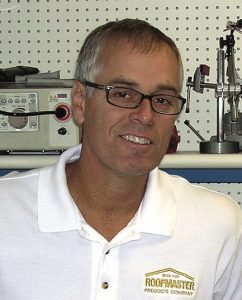Equipment Notes: Tank Spreaders
Fast & Efficient Solution for Liquid Applications
by Pat Amicucci, Northern California territory sales manager, Roofmaster Products Company

(Pat Amicucci has been with Roofmaster in his current position for 25 years as the Northern California territory sales manager. He is a certified Leister technician and has extensive experience and knowledge in all aspects of the construction industry, specializing in roofing equipment, tools, accessories, sales, and service. He can be reached at pat@roofmaster.com or (916) 296-6714.)
There are tank spreaders on the market that provide fast, efficient, and cost-effective solutions for spreading liquid adhesives, acrylics, and silicone on multiple surfaces, including metal roofs. We receive many inquiries about the use of these applicators. Most coating manufacturers approve this equipment, such as KARNAK, ERSystems®, GACO™, Tropical, APOC®, and others.
These units come with easy assembly instructions and can be shipped via UPS. Upon assembly, it is important to notice the holes in the bottom of the tank. There are two ways to control the flow rate of your product. One control is the operator’s walking speed, much like the mini-moppers used by hot asphalt installers. The other way to control flow is by enlarging the current holes with a 3/8’’ drill bit. It is recommended to start in the middle first and open up a hole or two on each side until the desired flow rate is achieved. Enlarge the outside holes last if needed.
When using silicones, be prepared to enlarge most holes. With larger holes it is necessary to walk at a faster pace to match the outflow of product. If the product is coming out too fast, it is suggested to plug up a hole or two starting from the outside. The machine has a natural tendency to put down about a gallon per 100 sq.ft., or approximately 15 mils, the average specifications required for elastomerics.
Some materials will orange peel if applied too heavily. This is just a starting point, as there are several other variables to consider. The weight of the machine will push out any product ahead of the roller and create a puddle in front of the roller. For best results, a puddle in front is usually desirable. If the puddle is too big, it will stream around the ends of the roller. This will then require the operator to back roll the coating. With practice, this extra step can be eliminated. However, with silicones or other materials requiring more than a gallon per square, or 15 mils per application, the faster method may be a large puddle and back rolling.
Here are some helpful tips to remember. Extend the life of the roller covers by keeping them wet with the coating. When the tank is empty, be sure to stop and refill. Don’t keep rolling the cover dry. This pulls the nap off the cover and mil thickness is lost.
During stops or breaks, cover the roller with plastic to keep the coating from curing on the roller. Also, put duct tape on the wheels and then pull it off at the end of the day. This will help with product build-up on the wheels and make it easier to roll the spreader.
Be sure to buy an extra tank. This makes it easy to swap out tanks when the coatings start plugging up the holes, especially after a lunch break. Simply remove the two wing nuts and swap with the new tank. After the product cures in the dirty tank, just pull it out like a glove. Call Roofmaster for any additional information or other options.